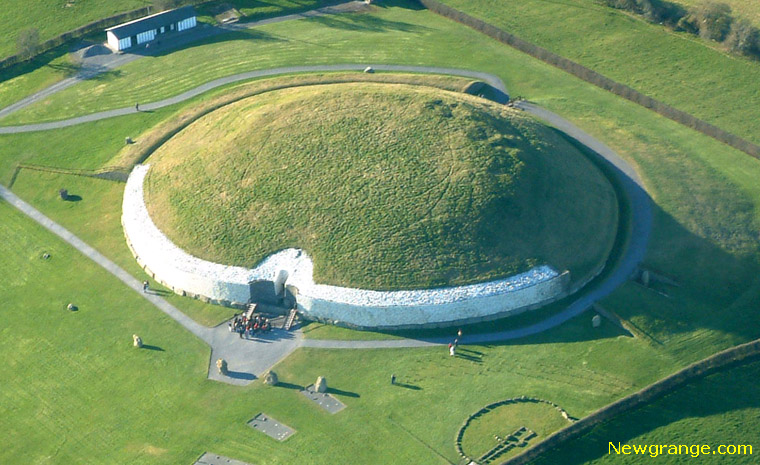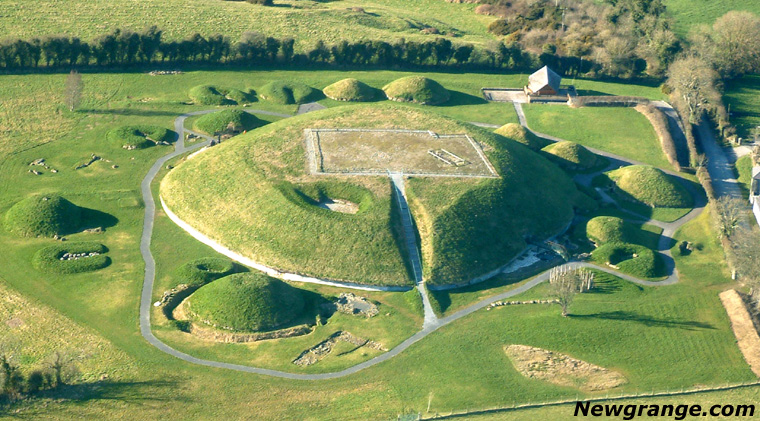Research boost for Brú na Bóinne complex
An article by Eileen Battersby - The Irish Times, 22 December 2008A wide-ranging new research project has been devised with the aim of developing a multidisciplinary approach to the study of one of Ireland's major archaeological landscapes. The Brú na Bóinne World Heritage Site Research Framework, which is being co-ordinated by Dr. Jessica Smyth of the Heritage Council, is following in the steps already taken by other world heritage sites.
These include Stonehenge and Avebury in Wiltshire and the world heritage site most similar to Newgrange, the prehistoric complexes at Orkney in Scotland, which consist of eight individual monuments scattered throughout the island archipelago. Central to the Brú na Bóinne study is the continuity of settlement in the landscape which spans from the early Stone Age to the present. Some 93 sites and monuments have to date been formally recorded, yet archaeologists believe there are many more sub-surface sites that could be identified through new technology.
Archaeologists are still uncertain as to the precise construction date of Newgrange itself. Most of the accepted data is now open to further examination using new dating technologies. Archaeological material stored for more than 40 years could now offer further answers.
Excavations carried out by Prof Michael J. O'Kelly during the 1970s, and later by Dr Ann Lynch in the 1980s, confirms the presence of an earlier burial mound at Newgrange. Although samples of this structure were gathered by Dr Lynch, they were never dated. Improved technology could finally offer conclusive evidence as to the age of this monument.
Archaeologist Dr Geraldine Stout, who has spent 30 years studying the Boyne Valley, speaking at Newgrange yesterday, said: "This research framework strategy is setting out a plan for all future archaeological work in the Boyne Valley whether it is development led or university led."
Pioneering excavations have been carried out in the Boyne Valley for more than 40 years led by Prof George Eogan of UCD and the Prof Michael J. O'Kelly of UCC. These excavations established the international significance of this area. Polymath Frank Mitchell of Trinity College first encouraged the young George Eogan to investigate a souterrain and small passage tomb at Townley Hall.
Prof Eogan then moved on to begin his life's work at Knowth and yet another of his Knowth publications was published last month by the Royal Irish Academy. Advances in technology and its impact of related disciplines such as geology, geomorphology and astronomy are introducing major new research aids to archaeology.
Geophysical surveying carries huge advances in that it is relatively inexpensive, quick and can reveal extensive hidden material without causing surface damage. It has effectively reduced the need for invasive excavation. "We have to work," said Dr Stout, "with scientists in the future. Archaeology is a science and is related to other sciences."
Following Prof O'Kelly's discovery of the solstice phenomenon in the early 1970s, Newgrange became famous. The Brú na Bóinne complex covers more than 3,300 hectares. "It is a huge area" said Dr Smyth, "there must be extensive sites and material out there waiting to be discovered and studied."
To download the full document click on Consultation Document, the document is a 1.4mb PDF file.
Boyne Valley Private Day Tour
 Immerse yourself in the rich heritage and culture of the Boyne Valley with our full-day private tours.
Visit Newgrange World Heritage site, explore the Hill of Slane, where Saint Patrick famously lit the Paschal fire.
Discover the Hill of Tara, the ancient seat of power for the High Kings of Ireland.
Book Now
Immerse yourself in the rich heritage and culture of the Boyne Valley with our full-day private tours.
Visit Newgrange World Heritage site, explore the Hill of Slane, where Saint Patrick famously lit the Paschal fire.
Discover the Hill of Tara, the ancient seat of power for the High Kings of Ireland.
Book Now
Home
| Visitor Centre
| Tours
| Winter Solstice
| Solstice Lottery
| Images
| Local Area
| News
| Knowth
| Dowth
| Articles
| Art
| Books
| Directions
| Accommodation
| Contact


